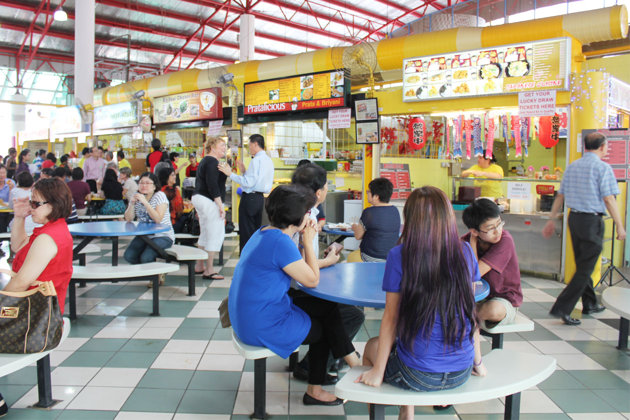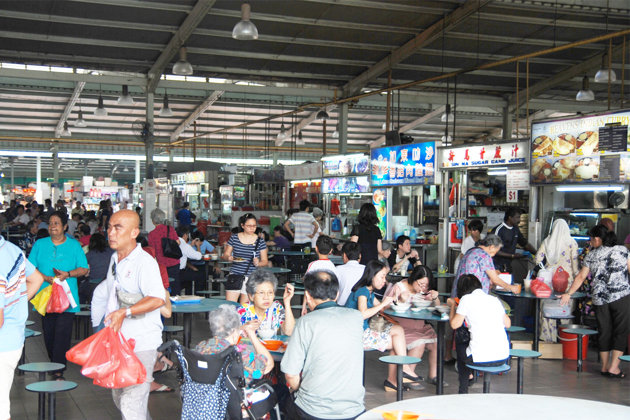Run Hawker Centres for no profits
By KF Seetoh - Thursday, Jan 09, 2014
I read with interest that our government is now looking at having private parties manage and run our beloved public hawker centres. I am excited, keen, concerned, amused, hopeful…all at once. In short, I am quite clueless about this move.
The announcement last week by the National Environment Agency (NEA) cited four hawker centres are up for this program – Block 207 New Upper Changi Road, Block 117 Aljunied Avenue 2, Block 20 Ghim Moh Road and Block 503 West Coast Drive. Their leases will expire on end May this year and that it should be run by non-profit organisations which can inject new thinking and operation models in managing this iconic makan institution of Singapore. They will be appointed as master tenants. The official news reports did not go beyond the cited facts and a lot of questions beckoned, in my mind at least.
For starters, the government had been running hawker centres for decades, and now, they suddenly believe that could be non-profit groups (NFG) out there that can do a better job. I mean, where will they come from. It is not as if there are folks who are officially or professionally trained to run hawker centres waiting in the wings to take this on. Also, what are the goals, targets or in official speak, KPIs (key performance indicators). The report says that NEA welcomes proposal from organisations that meet the requirements. Really, what requirements. The media did not question it. The head of the hawker division at NEA, Mr Richard Tan, recently responded to my Facebook post on this topic, saying we should not speculate, adding “The master tenant (MT) will receive a management fee for managing the centre. If the MT is good he should be able to reduce maintenance cost to arrive at a surplus which will be shared. End of day – it is to see who can manage centres more efficiently – private sector or NEA.” Ok, that was helpful, in so many ways especially the part about receiving a management fee for the work. It is quite easy to capitalise and profit on this under a non-profit system. Suppose a hard core commercial food court management team forms a so-called NFG to run this. They can take over all the drinks and refreshment stalls (at low rentals) and milk the profits. Sure, they have to share the spoils with NEA but it will deprive displaced folks who rely on running these stalls of an opportunity.

So, it’s like a big family chain of hotels now want professional hospitality companies like the Accor group or Marriott to manage it. But not quite so, as there are nada groups out there (let alone non-profit ones) that can seriously outdo the status quo. The NEA is doing a so-so to good job currently and we all are aware of the problems of hygiene and the constant availability of reliable cleaners at their over 100 hawker centres. In that same Facebook post, there were a host of concerns and questions. Ramesh Ramakrishnan Iyer felt that NEA, because it is a bureaucracy and not entrepreneurial by nature, may see this as expensive exercises, hence the need to “farm out”. But he adds that these NFGs may be entangled in the web of management viability chaos and lose focus on the guiding factors thus reduced to a “to hell with the quality of makan and the spirit of cuisine” situation. Mike Ang addressed the concerns of rental cost, with a simple point “lower the rental, then let’s talk about non or minimal profit”, after all, one KPI should be the affordability of the fare and the viability of the business as this was the original vision of running hawker centres. While some stalls pay as low as $50, some are paying as much as $3500 per hawker stall because of a market rate bidding system or crafty “sublet” situations.
Recently the social enterprise not-for-profit run Simpang Bedok food centre went belly up in spite of all its good intent and sincere efforts, and despite the support of A-lister names in the field of community and social enterprise mavens. Managing that iconic hawker centre, is very unlike operating food courts, coffeeshops or canteens – where our local food culture is headquartered.

Perhaps this new breed of NFG management should look into a new thought and approach to running hawker centres. It must attract a new young generation or else who would benefit from this move in future (notice we don’t see a lot of them at hawker centres these days). Understanding functional and practical menus and local food culture, demographic appeal, social media, ideas for visuals and signages, engagement touchpoints, new, more efficient ways of improving hygiene etc. should be looked at.
Perplexed somewhat, but I am excited and look forward to the realisation and reactions.


